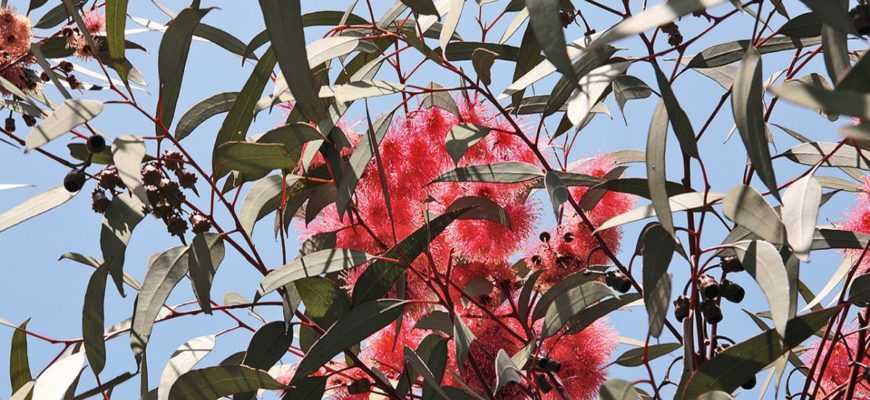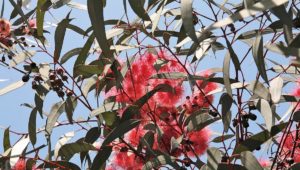
Find out more about the Eucalyptus Radiata plant of our Aromatherapy Herbarium blog series.

EUCALYPTUS RADIATA
Eucalyptus officinalis
Eucalyptus radiata
DESCRIPTION

Eucalyptus radiata is an Australian tree with a bluish grey trunk which may reach thirty metres and belongs to the Myrtaceae family.
ADVICE
Essential oil of Eucalyptus radiata is remarkably well-tolerated in skin application in young children: always use diluted to 50% in a vegetable oil.
Lemon-scented eucalyptus has specific properties: anti-inflammatory and analgesic (osteoarthritis, tendinitis, rheumatism, sprains, arthritis, headaches, painful menstruation). Its essential oil also treats skin disorders (Herpes zoster, athletes’ foot, mycoses, itching). It is also a good mosquito repellent.
DO NOT USE IN
– pregnant or breast-feeding women,
– children under the age of three years (under the age of seven years for oral administration and for Eucalyptus globulus),
– persons with a history of epilepsy (warning, especially in children who have had fever seizures),
– persons allergic to one of the components (geraniol, linalool, limonene),
– subjects with asthma without the advice of an allergologist before the first use,
– in case of treatment of more than a few days (contraceptive pill, anticoagulants, chemotherapy, etc.).
RECIPES
Fever
Take three or four times daily 2 drops of essential oil of Eucalyptus radiata on a neutral tablet allowing it to melt in the mouth.
Pour 10 drops of essential oil of Eucalyptus radiata in a spoonful of neutral base. Mix in bath water.
Flu
Pour a few drops of essential oil of Eucalyptus radiata on a handkerchief or in a bowl of hot water. Breath for ten minutes to prevent flu.
3 drops of EO of Eucalyptus radiata, 3 drops of EO of ravintsara. Apply on the chest two to three times daily for one week. (Not suitable for children under the age of seven years.)

A closed shell hides the flower stamens which come out when they grow, which gave the tree its Greek name (eu “well”, kaluptos “covered”). The leaves have oil glands and can capture solar energy on each of their faces, which makes them secrete an abundant nectar.
“The fever tree”, which has the rare virtue of cleansing its surroundings, was discovered in Australia in 1792 by the French naturalist Julien Houtou de La Billardière, who accompanied La Perouse and wrote an account of the expedition. Aboriginals used its leaves to treat their wounds and fevers. Its introduction in Europe dates back to 1856 when the commercial product started in the Australian state of Victoria. Eucalyptus was used to dry out and clean malaria-infested marsh regions as it absorbs large quantities of water and releases strongly anti-infectious emissions, thus one of its names Eucalyptus salubris.
CULTIVATION AND PRODUCTION
An almost exclusively Australian forest species including seven hundred species, and a treat for koalas, the eucalyptus spread over the other continents in Europe (Italy, Spain, Portugal where it is used for paper pulp), Africa (Morocco and Madagascar), Asia (China, India, Sri Lanka) and North and South America. It is found in all the pharmacopoeias of the planet. Australia, Morocco and Spain are the main exporters of essential oil of eucalyptus. In Tunisia, a colossal project of the Global Wood Holding of Geneva plans to plant in the Tatouine desert a forest to provide two million tonnes of eucalyptus wood per year for export.
FRAGRANCE
Eucalyptus radiata leaves have a strong camphor odour, slightly pungent, even though less than that of Eucalyptus globulus. Essential oil of eucalyptus has a characteristic, fresh and pleasant scent.
EXTRACTION AND YIELD
The yield of eucalyptus leave steam distillation is approximately 2%, i.e. two kilograms per hundred kilograms of plant.
CHEMICAL FORMULA
The active ingredients of essential oil of Eucalyptus radiata are mainly oxides (1,8-cineol: 72%-75%-80%) and a monoterpenol (alpha-terpineol).
MAIN INDICATIONS
Antiviral, decongestant and expectorant, Eucalyptus radiata or Eucalyptus globulus is the Attila the Hun of respiratory diseases, irrespective of whether they are viral (cold, flu) or bacterial (bronchitis, sinusitis, otitis). It is pleasant to breathe and a formidable nasal decongestant. Furthermore, it has the capacity of curing skin infections, support the immune system and energise.


Leave a Comment